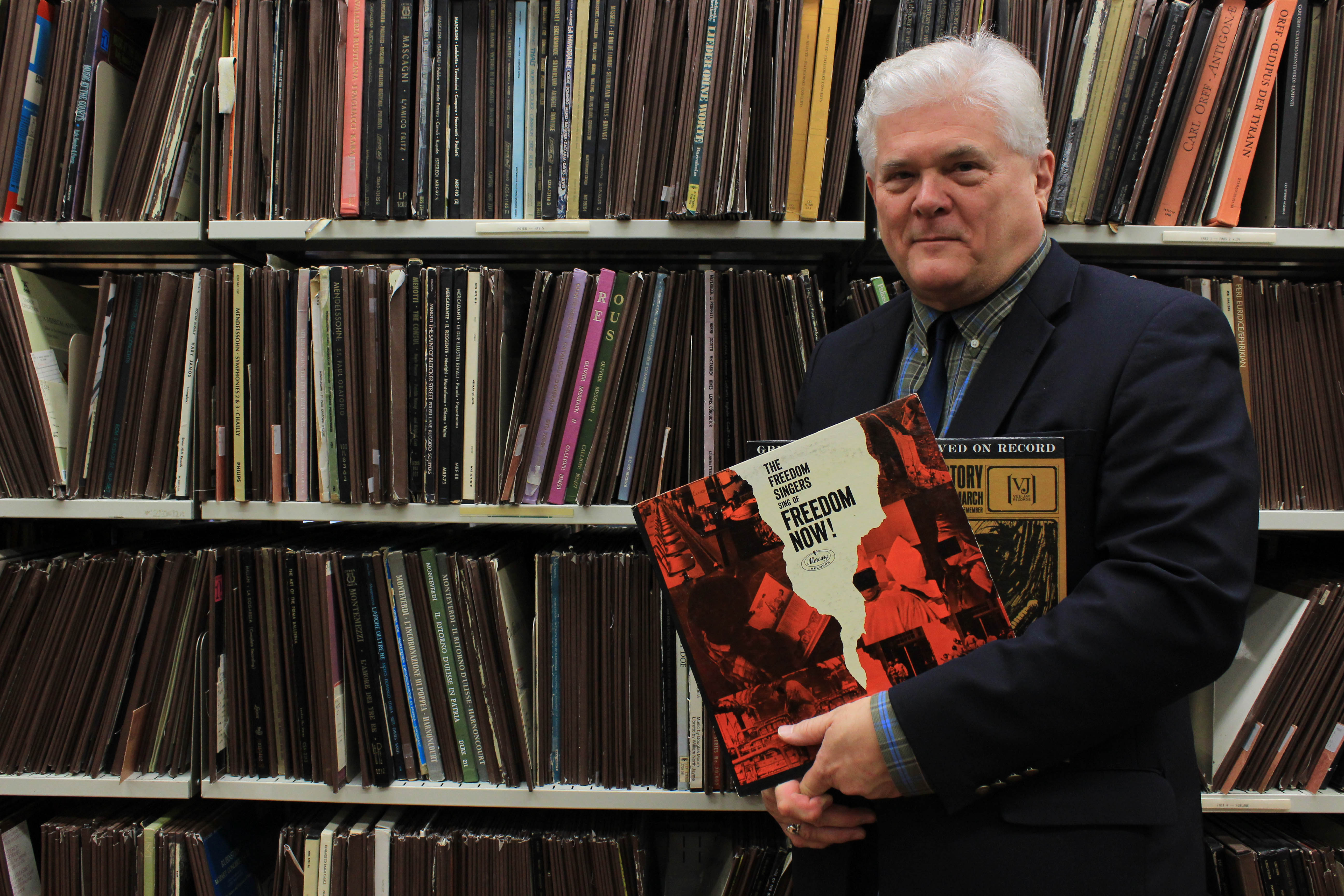 Story by Joy Moton; Photos by Rachel Leland
Story by Joy Moton; Photos by Rachel Leland
From the fields of slavery, to the protests of the civil rights movement, to the current Black Lives Matter movement, the melodies of gospel music have been a present force in carrying African-Americans through times of strife. Gospel music began with Negro spirituals and developed into the foundational roots of various genres of music including rock & roll, r&b, and pop.
Despite its significant presence in history as well as in music in general, gospel music began to disappear. Due to discrimination, most African-American musicians did not have the means to formally publicize their music. As a result, copyright information was absent and music became unidentifiable. With the move away from vinyls and record players, it was just a matter of time before this music would simply vanish.
A man transformed by the powerful harmonies of gospel music was deeply discontent with the fact that the old-time classics were disappearing. In 2005, Robert Darden, professor of Journalism, Public Relations and New Media wrote a column for The New York Times expressing his concern about these less prominent foundational gospel songs that seemed to fade away.
“I became alarmed and concerned that the vinyl from gospel music’s golden Age (1945-1970) was disappearing,” said Darden, who is a professor of journalism at Baylor. “Some figures have it as high as 75 percent of it as lost or unavailable.”
Philanthropist Charles Royce noticed Darden’s article and offered to fund what has become the Black Gospel Music Restoration Project. The project was designed to collect, digitize and preserve this historic music. Darden partnered with Baylor Libraries to create the Ray I. Riley Digitization Center and since its beginning, the project has enabled the digitization of as many as 4,000 songs with the largest collection of golden age gospel music in the world, Darden said.
Darden described how the depth of gospel music from the golden age is profoundly rich because it artistically communicates the sentiments of an entire nation.
“At the time when African-Americans owned very few newspapers, no radio stations, no TV stations and publishers weren’t publishing their books, they were releasing intensely personal, informative music and historians around the world in just the last few years have begun to realize this is a text worthy of study,” Darden said.
As a result of the historical significance that these songs carry, the project has made it possible for scholars studying Gospel music and African-American studies to come from all over the world to access this music. Darden’s project has allowed Moody Library to house one of the largest collections of sheet music of any kind. The role of libraries in communities has made a major shift from being information holders to locations that display interesting collections that aren’t typically found in museums.
“They’re not just a physical place to keep things, but to be gatekeepers and providers of information and unique collections of historical significance,” Darden said.
Darden has written “Nothing But Love in God’s Water,” which comprises two volumes that discuss the impact of gospel music throughout history. He originally intended to write two books about specific periods of gospel music throughout black history but he realized that it is an ongoing phenomenon that has reached other cultures. Darden saw that these songs that began as songs of hope and protest for slaves hundreds of years ago continued through Reconstruction, the Great Migration of African-Americans out of the South, the world wars, and the Montgomery Bus boycott. However, that’s not where they end.
“They pick up again with the sit-ins and the freedom rides and they don’t end with Resurrection City, they don’t end with the fall of the Berlin wall, they don’t end Arab Spring. They’re still going and it’s an unbroken, apostolic succession,” Darden said.
Darden even noticed that the music is crossing cultural boundaries. The Arab Spring of 2011 was a series of anti-governmental protests that arose throughout the Middle East in order to fight against dictatorships, brutality of security officials, rising prices, unemployment rates and corrupt governments. As he watched footage of the protests on BBC, the news would cut to Morocco or Egypt and he saw people of various races singing “We Shall Overcome.”
This was significant because this song was used as the anthem of the civil rights movement to promote the conviction that African-Americans would conquer racial discrimination.
“Every time oppressed peoples do some kind of resistance, these songs re-emerge,” Darden said.
The very song that gave protesters of the civil rights movement hope for equality was the same song that encouraged the people of the Middle East to persevere in their fight for better governments.
Darden’s project has served not only to preserve this music, but it has also provided the opportunity for albums to receive their own cover art. In connection with the project, one of the assignments given to students enrolled in a Package Design course at Baylor University is to design music covers for albums that never had the opportunity to get CD covers. Eric Ames, curator of digital collections for the Gospel Music Restoration Project, got the idea to allow students to display their talents through giving a visual element to an entirely music-based collection.
“The music is amazing, it stands on its own, but we’re trying to find new ways for Baylor students to plug into that collection and be creative with it,” Ames said.
Students were tasked to listen to songs from the album they were assigned and design a cover based on the emotions the songs evoked. Students turned in a diverse set of work, yielding designs that portrayed what the album would have looked like when it was recorded and art that exemplified what the cover art would look like if the music were released today. The students were rewarded for the work that they produced by having their designs featured in an exhibit in Moody Library titled “Visions of Rapture.”
“It was exciting for them,” Ames said. “It was informative and they said they loved the challenge of being able to take something they weren’t familiar with and give it a visual identity.”
Students that have had the opportunity to learn about the Gospel Music Restoration project through other classes have also gained a profound appreciation for this project. Christian Broussard, a junior at Baylor University and the director of the Heavenly Voices choir, has a heartfelt admiration for this project because the songs that it introduced to him were able to convey the story behind why the songs were written and the conditions of the society surrounding the musician.
“I think we would lose a large amount of gospel music if we didn’t have this collection and I’m extremely grateful for this collection because it’s definitely broadened my scope of what gospel music is,” Broussard said.
The project has had so much influence that it has its own exhibit featured in the Smithsonian’s National Museum of African American History and Culture. Aside from being mesmerized by his own exhibit, Darden expressed gratitude for the opportunity he had to mingle with other donors and explore the other displays in the museum.
The impact that the project had within the small confines of Waco is expected to expand dramatically since an estimated 8 million people will visit the museum and have the opportunity to hear this music each year, Darden said.
Darden referenced a quote from the late writer Zora Neale Hurston about the continual impact of the spirituals: “They’re always here with us; they’re slumbering waiting for our time of need.”
“That was before the civil rights movement before they become the freedom songs,” Darden said. “She was right; they don’t ever go away and they never will.”

